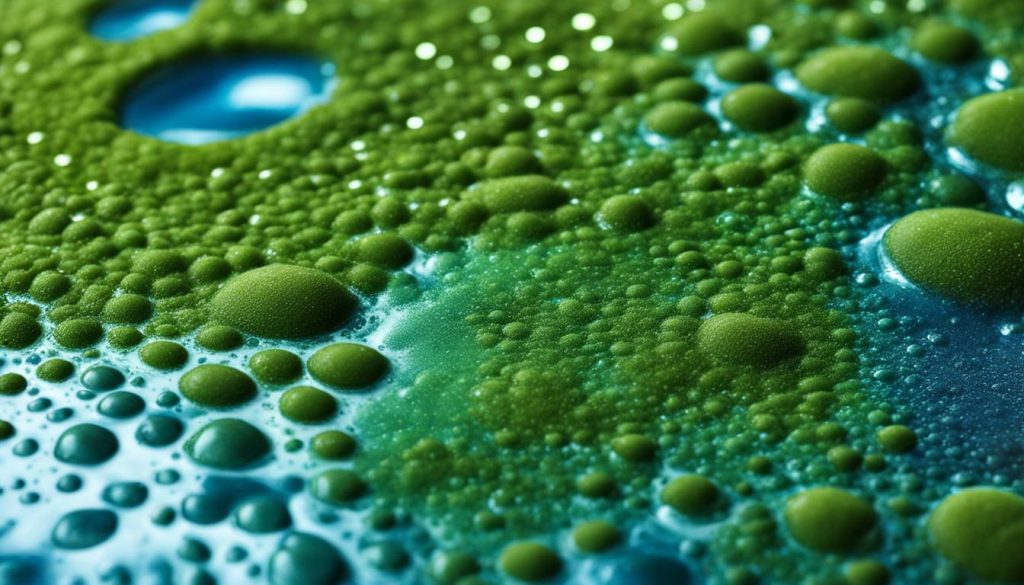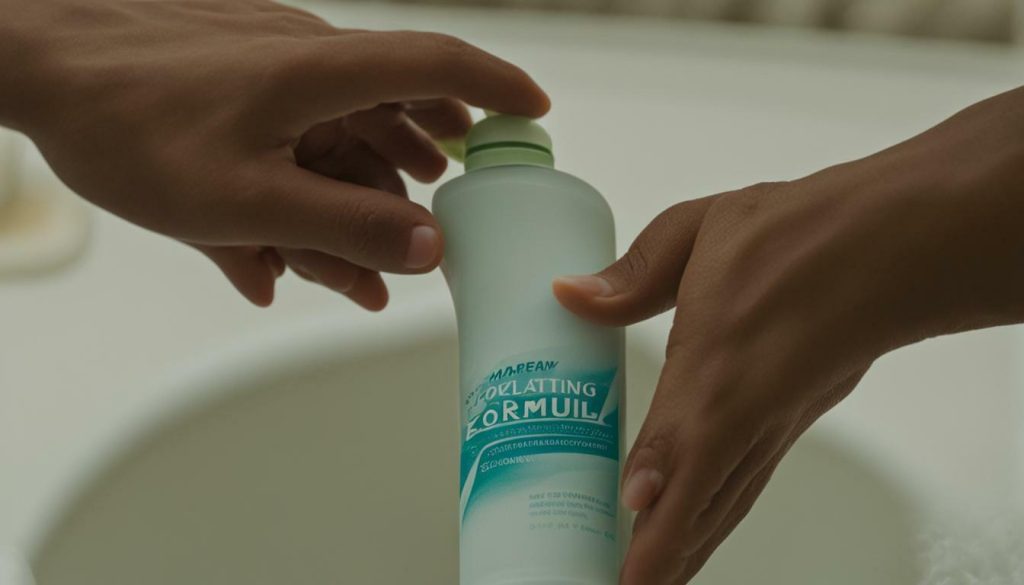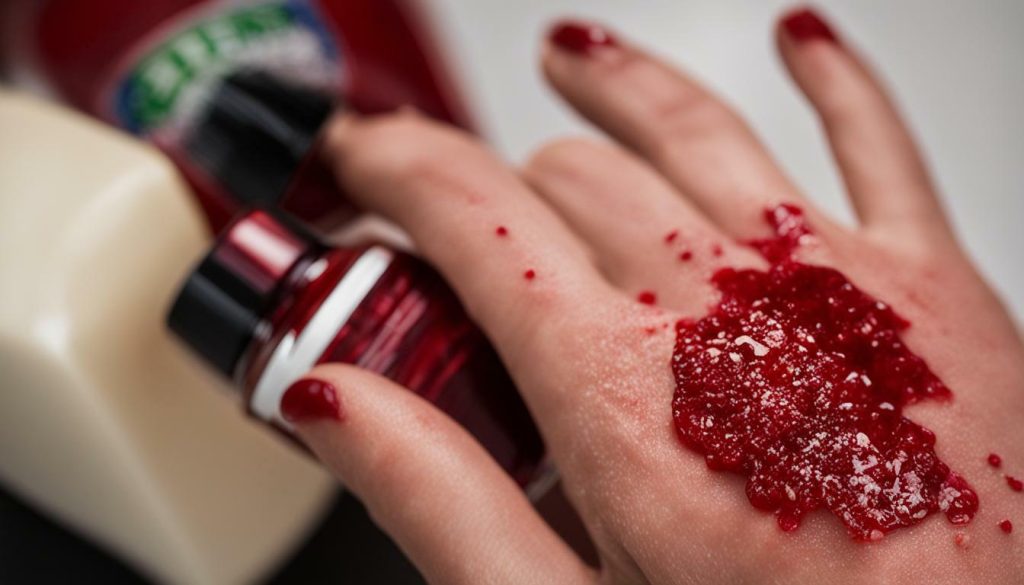Body wash is an essential part of your hygiene routine, helping to remove dirt, oil, and bacteria from your skin. But have you ever wondered how body wash works to achieve this? In this comprehensive guide, we will explore the science behind body wash and how it works to ensure optimal hygiene and cleanliness for your skin.
- Body wash is a liquid cleanser that helps to remove dirt, oil, and bacteria from your skin.
- Understanding the composition of body wash can help you choose the right product for your needs.
- Surfactants in body wash reduce the surface tension of water, allowing it to mix with oil and dirt on the skin.
- The mechanism of cleansing with body wash involves the formation of foam or lather.
- Using body wash correctly is essential for optimal hygiene and cleanliness.
Understanding the Composition of Body Wash
Body wash is a liquid cleanser that typically contains a combination of water, surfactants, oils, fragrances, and other ingredients. These ingredients work together to remove dirt, oil, and dead skin cells from your body, leaving your skin feeling clean and refreshed.
The composition of body wash varies depending on the brand and type of wash. However, all body washes contain surfactants, which are the primary cleansing agents. These surfactants reduce the surface tension of water and enable it to mix with oil and dirt on your skin, making it easier to rinse off.
In addition to surfactants, body washes may contain emollients and humectants, such as glycerin and aloe vera. These ingredients help to hydrate and moisturize your skin, improving its texture and appearance.
Some body washes may also include exfoliants, such as microbeads or crushed walnut shells, which help to remove dead skin cells and unclog pores. However, it’s important to use these exfoliating body washes with care, as they can be too harsh for sensitive skin.
Surfactants are the key ingredients in body wash that make it effective at cleaning your skin. These soap molecules break down the oil and dirt on your skin and enable it to be rinsed away with water. Surfactants also create the foaming or lathering effect that many people associate with body wash.
There are several types of surfactants used in body washes, including sodium lauryl sulfate (SLS), sodium laureth sulfate (SLES), and cocamidopropyl betaine. These surfactants differ in their effectiveness and their potential to irritate or dry out your skin. Some people may be sensitive to certain surfactants and should opt for gentler formulations.
Breaking Down Surfactants in Body Wash
Surfactants are the key ingredients in body wash that make it effective in removing dirt and impurities from the skin’s surface. The word surfactant is short for “surface-active agent,” referring to its ability to reduce the surface tension of water and loosen dirt and oils on the skin.
One type of surfactant commonly found in body wash is sodium laureth sulfate (SLES). SLES is derived from coconut oil and is known for its ability to produce a rich lather. When SLES is mixed with water, it forms soap molecules that have a hydrophilic (water-loving) head and a lipophilic (oil-loving) tail. These soap molecules surround dirt and oil on the skin, emulsifying them and making them easier to wash away with water.
Did you know? Surfactants are also used in other household products, such as dish soap and laundry detergent, for their ability to remove dirt and stains.
Body washes may contain other types of surfactants as well, each with its own unique properties and benefits. For example, cocamidopropyl betaine is a mild surfactant that helps create a luxurious foam and is gentle on the skin.
Surfactants not only cleanse the skin but also play a role in creating a rich lather that enhances the sensory experience of using body wash. However, some people may experience skin irritation or dryness from prolonged use of surfactants. It’s important to choose a body wash with a gentle formulation if you have sensitive skin.
The Mechanism of Cleansing with Body Wash
Have you ever wondered how exactly body wash cleanses your skin? It all comes down to the cleansing mechanism, which involves the creation of foam or lather when mixed with water.
Body wash contains surfactants, such as sodium laureth sulfate, which reduce the surface tension of water, allowing it to mix with oil and dirt on the skin. When you apply body wash to your skin and mix it with water, the surfactants create foam or lather, which enhances the cleansing properties of the body wash.
The foam or lather helps to lift dirt, oil, and bacteria from the surface of the skin, making it easier to rinse away. This is why you should massage your body wash into a lather and work it into your skin thoroughly for the best results.
However, it is important to note that excessive foaming may not always be a good thing. While it may make you feel like you are getting a deeper clean, it can also strip your skin of its natural oils and cause dryness or irritation. That’s why it’s important to choose a body wash that is gentle and appropriate for your skin type.
The cleansing mechanism of body wash is an essential part of maintaining optimal hygiene and cleanliness for your skin. By using a body wash that creates a healthy foam or lather, you can effectively remove impurities and bacteria from your skin, leaving it feeling fresh and clean.
Hydration and Moisturization with Body Wash
Aside from cleansing, body wash can also provide hydration and moisturization to your skin. This is especially important because the skin barrier can be disrupted during the cleansing process, leading to dryness and irritation.
Many body washes contain ingredients such as glycerin or hyaluronic acid to help hydrate the skin. These ingredients work by attracting water molecules and locking in moisture, leaving your skin feeling soft and supple.
In addition to hydration, some body washes also contain moisturizing ingredients like shea butter or coconut oil. These ingredients can help strengthen the skin barrier and prevent moisture loss, further enhancing the hydrating benefits of your body wash.
When selecting a body wash for hydration and moisturization, look for ingredients that are known to be effective hydrators and moisturizers and are appropriate for your skin type. If you have particularly dry skin, you may want to opt for a body wash with a higher concentration of moisturizing ingredients.
Targeting Specific Skin Concerns with Body Wash
If you have specific skin concerns, such as dryness, acne, or sensitivity, choosing the right body wash can make a significant difference.
Exfoliation: If you struggle with rough or bumpy skin, look for a body wash that contains exfoliating beads or acids. These ingredients work to remove dead skin cells, revealing smoother, softer skin underneath. However, be mindful of over-exfoliating, which can damage the skin barrier and cause irritation.
Acne-prone skin: Body washes that contain salicylic acid, benzoyl peroxide, or tea tree oil are beneficial for those with acne-prone skin. These ingredients work to unclog pores, reduce inflammation, and prevent future breakouts.
Sensitive skin: If you have sensitive skin, look for body washes that are free of fragrances, dyes, and harsh chemicals. Additionally, opt for a formula that contains moisturizing ingredients like glycerin or ceramides to prevent dryness and irritation.
Regardless of your specific skin concerns, it’s essential to use a body wash that is pH-balanced and gentle on the skin. Avoid using hot water, which can strip the skin of its natural oils, and instead opt for warm water to prevent further dryness or irritation.
Proper Application and Usage of Body Wash
To get the most out of your body wash, proper application and usage are crucial. Here are some showering tips to help you achieve optimal cleanliness and hygiene:
1. Wet Your Skin
Before applying body wash, wet your skin thoroughly with warm water. This helps to open up your skin pores, allowing the body wash to penetrate deep into your skin for a thorough cleanse.
2. Apply Body Wash to a Loofah or Washcloth
Squeeze a small amount of body wash onto a loofah or washcloth. This helps to create a rich lather and distribute the body wash evenly over your skin.
3. Gently Massage Your Skin
Using the loofah or washcloth, gently massage your skin in circular motions. Pay attention to areas that are prone to sweating, such as your underarms and feet.
4. Rinse Thoroughly
Rinse your skin thoroughly with warm water, making sure to remove all traces of body wash. This helps to prevent any residue from clogging your pores or drying out your skin.
5. Pat Dry with a Towel
After showering, gently pat your skin dry with a towel. Avoid rubbing your skin vigorously as this can cause irritation.
By following these simple showering tips, you can ensure that your body wash is effectively cleansing your skin, leaving it feeling refreshed and smelling great.
Safety Considerations and Allergies
While body wash is generally safe for use, it’s important to be aware of potential safety considerations and allergies that may arise. Some individuals may have skin sensitivity or allergic reactions to certain ingredients commonly found in body washes, such as fragrances, preservatives, and sulfates.
If you experience any adverse reactions, such as itching, redness, or swelling, discontinue use immediately and consult with your healthcare provider. It’s also advisable to perform a patch test on a small area of skin before using a new body wash to determine if you have a sensitivity or allergy to any of the ingredients.
Additionally, it’s important to keep body wash out of your eyes and mouth, as it may cause irritation or discomfort. If contact with eyes or mouth occurs, rinse thoroughly with water.
When selecting a body wash, it’s a good idea to choose one that is specifically formulated for your skin type and free of any ingredients to which you may be sensitive or allergic. Reading product labels and researching ingredients can also help you make informed decisions about which body wash is right for you.
Choosing the Right Body Wash for Your Needs
Choosing the right body wash for your needs can seem overwhelming with so many options on the market. However, there are a few factors to consider that can simplify the process.
Consider Your Skin Type
First, consider your skin type. If you have dry skin, look for body washes that contain moisturizing ingredients like glycerin or shea butter. Those with oily skin may benefit from a body wash with salicylic acid to help exfoliate and control oil production. If you have sensitive skin, opt for a body wash that is free from harsh fragrances and preservatives.
Take Personal Preferences Into Account
Personal preferences should also be taken into account. Do you prefer a body wash with a strong scent or a mild one? Would you rather have a creamy, lotion-like consistency or a more foamy texture? These personal preferences can influence which body wash you choose.
Try Different Options
If you’re unsure which body wash to choose, try out a few different options to see what works best for you. Many brands offer travel-sized versions of their body washes, making it easy to test them out without committing to a full-sized bottle.
By considering your skin type, personal preferences, and testing out different options, you can find the perfect body wash for your needs.
Conclusion
Choosing the right body wash and utilizing proper application techniques can help you achieve optimal hygiene and cleanliness for your skin. With a variety of options available on the market, it is essential to consider factors such as your skin type, personal preferences, and fragrance options when selecting the right body wash for your needs.
Understanding the science behind body wash, including the composition of its ingredients and the mechanism of cleansing, can help you make informed choices about your hygiene routine. In addition, body wash can provide hydration and moisturization benefits and can address specific skin concerns, such as acne-prone or sensitive skin.
However, it is important to keep in mind safety considerations and potential allergies or sensitivity to certain ingredients. By following proper usage guidelines and being aware of potential allergens, you can maintain healthy skin and avoid adverse reactions.
In conclusion, by selecting the right body wash and following proper usage guidelines, you can achieve optimal cleanliness and maintain healthy skin. Incorporating body wash into your hygiene routine can help you feel fresh and rejuvenated every day.

Hey there! I’m Dr. Mary Noland, your trusted authority in dermatology. My 17-year rollercoaster ride in skin science has been nothing short of a masterclass. Whether you’re a newbie or a familiar face, I’m here with open arms and Medicare-friendly services, dedicated to creating your perfect skin haven.
But hold up! There’s more to me. When I’m not elbow-deep in dermatology, I’m lighting up derma blogs with insights that peel back the layers of skin health. Also, as the proud captain of ‘buybodywash.com‘, I provide all the body care goodness you need!
Trust me; I’m more than just a white coat. I’m here to lend an ear, share a laugh, and bring calm with a reassuring voice that’s comforted countless patients.
So, meet Dr. Mary Noland – your dermatologist and your guide and friend on the path to radiant skin. I am excited to meet you soon!









